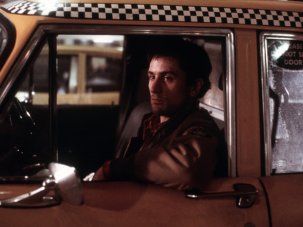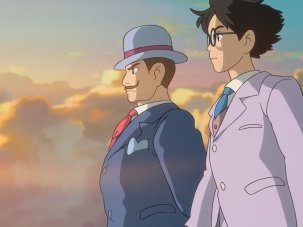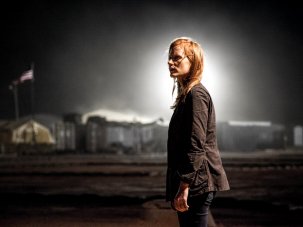World War II Gun Camera Ca.1945
in the Internet Archive’s WWII Archive.
This piece of 16mm US Navy film, lodged deep in the WWII Archive collection of the larger, nonprofit Internet Archives, is unlikely ever to be drafted into a new-made documentary. As a public-domain film, not subject to copyright law, it can be repurposed without permission, free of cost. But being of poor quality and competing with clearer, sharper, high-definition historical moving image, it’s fated always to be benched, never to be picked to play for team. And still, irrefutably, it wears the war-footage jersey.
What is the value of genre-stock in this kind of condition? Who’d have the patience for it, to squint through the brume of the print’s disrepair for its hypothetical potential, when its brawnier teammates – called ‘Graphic’, ‘Rare’, ‘Recently Declassified’, or sporting more problematic monikers like ‘Incredible’ and ‘Outstanding’ – proliferate the web, circulated by male-interest and entertainment sites like reddit and eBaum’s World? Mined from YouTube channels like the Romano Archives’ UnknownWW2InColor, and rubbing shoulders with chauvinist click bait of uniformly exclamatory variety, this first-string video content is, most frequently, gun-camera footage, purveying something in the ballpark of a cockpit POV, and appealing to the host-sites users in the way first-person shooters like Doom and COD do gamers. So if avatar-verisimilitude is the varsity standard, what future for the substitute?
A compilation of gun-camera footage, this month’s archive film records – according to original labelling by the National Archives – an air raid on the coastal, industrial city of Hamamatsu in Japan. Hamamatsu in South Honshu was subject to strategic bombing on several separate occasions towards the end of the Pacific War. However, that the film was acquired from the Naval Photographic Center, and contains footage of what’s identified in the shot list as a South Dakota-class battleship (as well as an Essex-class aircraft carrier), suggests the recordings may be traced more precisely to the closing weeks of WWII, sometime around 29 July 1945 when the city was bombarded by US and Allied warships.
There could be no way of gleaning this narrative framework from the footage itself, and that has greatly to do with the principle of the gun camera. Its function to enumerate on-target hits, the gun camera – a relatively new technology when deployed by the Royal Flying Corps during World War I, and a standard fixture of fighter planes by 1945 – was trigger-activated, affording a short shot-length from a single, static angle where mounted in the aircraft wing. Each shot is, symptomatically, independent of the next, so the film, taken as whole, hasn’t the pillar-to-post narrative of progression of the first-person-shooter titles it purportedly inspired.
The film seems not to have been edited, just indexed. Numbered intertitles have been inserted, but are rather more eccentric than expository since these indices aren’t serial and jump – 31 to 33, 46 to 65. Perplexing matters further, there are more cuts than there are index plates, and the figures – climbing too high too fast – seem to pertain to some ulterior continuum. These intertitles – another kind of kill-tally – might have imparted some order to the film’s disjunctive content; instead, they ratify the randomness we see.
And what there is to see is, in the main, much of a muchness: the trajectory of tracers fired at indecipherable enemy targets; detonations over ant-farm land, and sea. The ejection of yellow-headed rockets from the bottom corners of the frame encourages a kind of nearsightedness, while the film’s limited colour spectrum plays havoc with spatial awareness: yellow interchangeably fire and sun; black interchangeably distant cloud and smoke blown near the gunsight.
(But if we’ve difficulty making out the detail in a flat and grey-scale surface zero, it isn’t all the fault of strobing and diffuseness. Within a year of the war’s ending, a US Air Force survey determined that it had devastated, flattened, over 60 per cent of the city.)
Faced with sameness and inscrutability, the eye soon adjusts, expecting rather not to see than see, and recognise. At times, the footage could almost be taken for nonrepresentational film: in place of comprehensible picture, something nearer typography.
We become learned in its language: its common nouns – or constants – are the yellow pips of pyrotechnic ammo loosed into depthless blue, or – at 1m 47s – crisscrossing the frame like fireflies; the white scuff of surf; the Emerald City silhouette of smokestacks and masts; and the unimpeachable, pitching horizon – the viewfinder rolling its axis like a bubble in a spirit level.
But in this by-and-large expressionist chaos, there are four or five instances of relative and thus arresting clarity: at 3m 10s, a column of black smoke, conical like a tornado; at 4m 46s, a slug of white smoke, furring the length of a train; a sunset at 8m 52s; and, most strikingly, people at 1m 51s. These are three soldiers: one seeming to motion “Down!” with an exultant stroke of his arm; another rising to his feet; a third running right to left as a burning plane plummets into ocean – nighttime ocean only made visible as the plane approaches near enough the water that it mirrors back the blaze. It is as if the sea were created upon the plane’s disturbing the surface and, seconds later, turning spray to spreading fire.
There is a biological feel to this footage, as if it all took place in an agar plate, and with so much of its imagery recalling myopic nature (like the gnat cloud of the print’s decomposition) we are reminded that aerial warfare does indeed occur in nature; isn’t contained, separate in the stratosphere.
Francis Ford Coppola’s Vietnam-narrative Apocalypse Now opened on nature: with green palms and the warped sound of a helicopter which – flying past in the foreground – stirred up coloured smoke streamers that whelmed the lens. They washed it orange, so that one could wonder was the staining in or of the image; captured, or processed in pre-tinted stock? Mixing the realism of the single take with multiple exposure, the camera panned upon the trees’ combustion and through the smouldering surfaced the face of the film’s principal character – in close-up, upside-down. The ceiling fan in his room came after, spinning centre-screen, its rotor blades rhyming with the rotors of helicopters on the audio track. By this opening sequence, Coppola, cinematographer Vittorio Storaro and editor Walter Murch surely hoped to engender – with partial dissolves, artificial colour – the same sense of dissociation that’s native to the crude gun camera footage.
Can there be such a thing as a nonstory war film? Must there be narrative to bring home the fog of war, or can the uncanny in conflict be communicated by abstraction? Can identification with a WWII gunner, empathy with first-hand experience of war, be so easily afforded? Doesn’t the snug familiarity of a pin-sharp positional image make us doubt the legitimacy of our sense of being there? Don’t or shouldn’t images of war exact new ways of seeing?
Freud’s preferring “the idea of being robbed of one’s eyes” to the more established definition of the uncanny – as something eerie; as being deceived by something both familiar and unfamiliar – seems apposite to the experience of watching this archive footage, that does not recompense the same pair of eyes we bring to a feature film, a blockbuster, Apocalypse Now.
Is not the clip’s tug-of-war with itself, its flashes of immediacy socketed in soft-focus confusion, the better able to convey the cognitive dissonance of the fighter pilot – if, like Yeats’ Irish Airman in this “tumult in the clouds”, he takes no side; belongs to no team.
“I know that I shall meet my fate,
Somewhere among the clouds above;
Those that I fight I do not hate,
Those that I guard I do not love.”
-
The Digital Edition and Archive quick link
Log in here to your digital edition and archive subscription, take a look at the packages on offer and buy a subscription.







